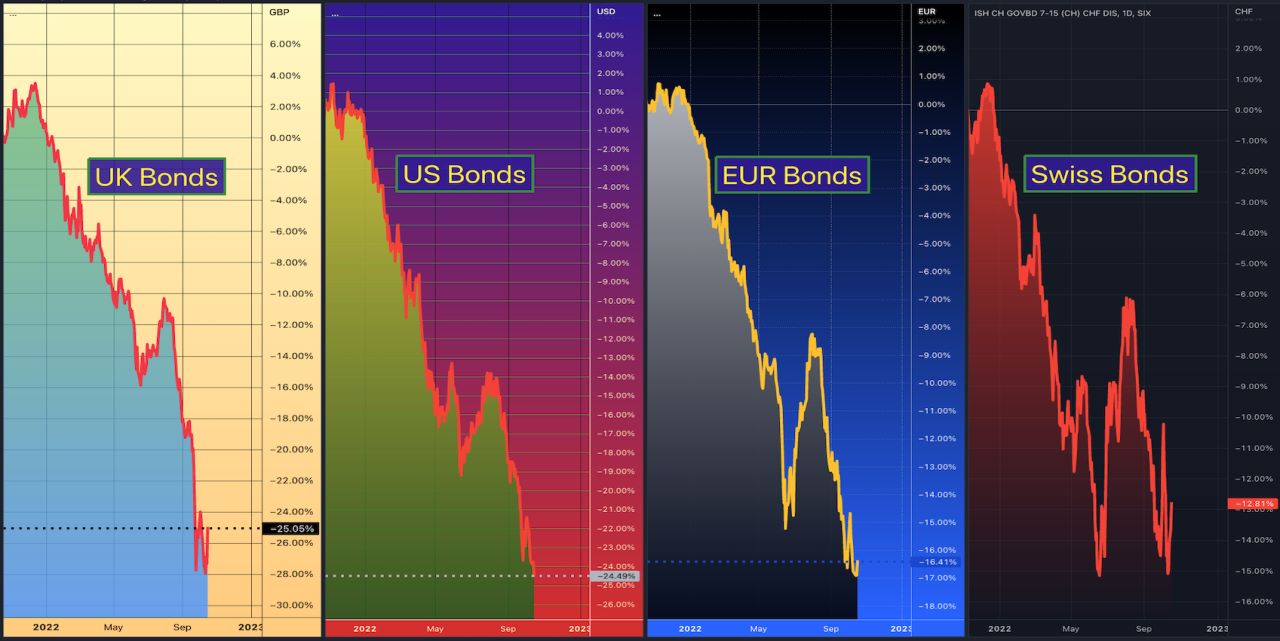

Finance
Why Are Pension Funds Dropping?
Published: January 23, 2024
Discover the reasons behind the decline in pension fund investments and the impact on the finance sector. Explore the implications and potential solutions.
(Many of the links in this article redirect to a specific reviewed product. Your purchase of these products through affiliate links helps to generate commission for LiveWell, at no extra cost. Learn more)
Table of Contents
Introduction
Pension funds, once considered the bedrock of retirement security, are experiencing a significant shift that has garnered attention from financial experts and retirees alike. These funds, established by employers to provide a steady income for employees after retirement, are facing unprecedented challenges in today's rapidly evolving economic landscape. Understanding the factors contributing to the decline of pension funds is crucial for both current and future retirees, as well as for policymakers and financial institutions.
The traditional concept of pension funds has undergone a transformation in recent years, prompting a reevaluation of investment strategies, demographic shifts, economic challenges, and regulatory changes. These factors collectively contribute to the complexities surrounding pension funds and their sustainability. As we delve into the intricacies of these challenges, it becomes evident that the implications extend far beyond the financial realm, impacting the livelihoods and well-being of retirees who have relied on these funds for their retirement security.
The following sections will explore the multifaceted reasons behind the decline of pension funds, shedding light on the implications for retirees and the broader financial landscape. By examining the shift in investment strategies, demographic shifts, economic challenges, and regulatory changes, we can gain a comprehensive understanding of the forces at play and their far-reaching effects. This exploration is essential for navigating the evolving landscape of retirement security and fostering informed decision-making for individuals, financial institutions, and policymakers alike.
Shift in Investment Strategy
One of the primary drivers behind the decline of pension funds lies in the fundamental shift in investment strategy. Traditionally, pension funds favored a conservative approach, with a significant allocation to fixed-income securities and bonds to ensure stability and consistent returns. However, the prolonged period of low interest rates has compelled pension funds to seek higher yields, prompting a pivot towards riskier assets such as equities, real estate, and alternative investments.
This shift is driven by the quest for higher returns to meet the mounting pension obligations amidst a challenging investment landscape. While the pursuit of higher yields presents opportunities, it also introduces heightened volatility and exposure to market fluctuations. The increased reliance on equities and alternative investments amplifies the vulnerability of pension funds to market downturns, posing a substantial risk to the long-term sustainability of these funds.
Furthermore, the shift in investment strategy has implications for portfolio diversification and risk management. As pension funds navigate the complexities of a low-yield environment, they encounter the delicate balance between pursuing higher returns and mitigating the associated risks. The quest for yield has led to a reevaluation of asset allocation, with a greater emphasis on diversification across global markets and asset classes.
While the shift in investment strategy presents opportunities for enhanced returns, it also underscores the imperative for robust risk management and strategic asset allocation. The repercussions of this shift reverberate across the financial landscape, underscoring the intricate interplay between investment decisions, market dynamics, and the long-term sustainability of pension funds.
Demographic Shifts
Demographic shifts play a pivotal role in shaping the challenges faced by pension funds. The aging population, coupled with increasing life expectancies, has exerted substantial pressure on pension funds, necessitating a reevaluation of sustainability and adequacy. As retirees outnumber the working population in many regions, the traditional support mechanism of pension funds encounters strain, compelling a reassessment of funding mechanisms and retirement policies.
The demographic landscape also reflects evolving workforce dynamics, including shifts in employment patterns, prolonged careers, and the rise of the gig economy. These changes have significant implications for pension funds, as they navigate the complexities of varied employment structures and contribution patterns. The traditional model of employer-sponsored pensions faces adaptation in the face of changing employment dynamics, calling for innovative solutions to accommodate diverse workforce arrangements.
Moreover, demographic shifts encompass broader societal changes, including family structures and intergenerational dynamics. The evolving landscape of familial support and caregiving responsibilities introduces complexities for pension funds, as they strive to align with the changing fabric of social dynamics. The interplay of demographic shifts and familial structures underscores the intricate web of considerations that underpin the sustainability and relevance of pension funds in an evolving society.
As pension funds grapple with the implications of demographic shifts, they are compelled to adopt a forward-looking approach that accommodates the evolving needs and expectations of a diverse and dynamic population. The intersection of demographic trends and retirement dynamics underscores the imperative for holistic and adaptive strategies to ensure the continued viability and efficacy of pension funds in supporting retirees amidst demographic transformations.
Economic Challenges
The landscape of pension funds is significantly influenced by a myriad of economic challenges that have reshaped the traditional paradigms of retirement security. Persistent low interest rates, coupled with volatile market conditions, pose formidable hurdles for pension funds seeking to generate sustainable returns to meet their long-term obligations. The prolonged low-yield environment has compelled pension funds to reassess their investment strategies, introducing complexities in balancing risk and return.
Furthermore, economic uncertainties, including geopolitical tensions and trade dynamics, contribute to the intricate tapestry of challenges confronting pension funds. The interconnectedness of global markets and the ripple effects of geopolitical events underscore the heightened volatility and uncertainty that pension funds must navigate in their pursuit of financial stability and growth.
The impact of economic challenges extends beyond investment dynamics, encompassing broader fiscal considerations and regulatory frameworks. Pension funds operate within a complex web of economic policies and regulatory landscapes, with evolving compliance requirements and governance standards shaping their operational environment.
Moreover, the economic challenges manifest in the form of fiscal pressures on governments and employers, influencing the sustainability of pension funding mechanisms. The financial health of sponsoring employers, coupled with governmental fiscal policies, intertwines with the stability and adequacy of pension funds, underscoring the intricate interplay between economic dynamics and retirement security.
As pension funds confront these economic challenges, they are compelled to adopt a resilient and adaptive approach, integrating robust risk management practices and strategic foresight to navigate the complexities of the economic landscape. The imperative for agility and innovation in the face of economic headwinds underscores the resilience and adaptability required to ensure the long-term sustainability of pension funds amidst evolving economic dynamics.
Regulatory Changes
Regulatory changes wield a profound impact on the landscape of pension funds, shaping the operational framework and governance dynamics that underpin retirement security. The evolving regulatory landscape introduces a paradigm shift in compliance requirements, governance standards, and fiduciary responsibilities, compelling pension funds to navigate a complex web of legal and regulatory frameworks.
The regulatory environment encompasses a spectrum of considerations, ranging from prudential standards and risk management protocols to disclosure requirements and investment guidelines. Pension funds are subject to a stringent regulatory framework that mandates transparency, accountability, and prudent stewardship of assets, reflecting the broader imperative of safeguarding retirement savings and ensuring fiduciary integrity.
Moreover, regulatory changes extend beyond domestic jurisdictions, encompassing international standards and cross-border regulatory frameworks that influence the operational landscape of pension funds. The interconnectedness of global financial regulations introduces complexities for pension funds operating across diverse markets, necessitating a nuanced understanding of cross-border compliance and regulatory convergence.
The evolving regulatory landscape also reflects a heightened focus on environmental, social, and governance (ESG) considerations, shaping the investment strategies and stewardship practices of pension funds. The integration of sustainable and responsible investment principles underscores the evolving regulatory expectations and societal imperatives that underpin pension fund governance and operational frameworks.
As pension funds navigate the intricacies of regulatory changes, they are compelled to adopt a proactive and adaptive approach, integrating robust compliance mechanisms and governance structures that align with the evolving regulatory landscape. The imperative for agility and foresight in the face of regulatory transformations underscores the resilience and adaptability required to ensure the continued efficacy and integrity of pension funds amidst evolving regulatory dynamics.
Impact on Retirees
The multifaceted challenges confronting pension funds have profound implications for retirees, shaping the landscape of retirement security and financial well-being. The evolving dynamics of pension funds exert a tangible impact on the livelihoods and retirement prospects of individuals who rely on these funds as a cornerstone of their financial stability.
As pension funds navigate the complexities of investment strategies, economic challenges, demographic shifts, and regulatory changes, the implications reverberate across the retirement landscape. Retirees are confronted with the repercussions of these dynamics, encompassing considerations of income adequacy, sustainability of pension benefits, and the overall security of their retirement provisions.
The shift in investment strategy introduces volatility and uncertainty, influencing the stability and growth of pension funds. Retirees are consequently exposed to the ramifications of market fluctuations and investment performance, with potential implications for the adequacy of their retirement income and the long-term sustainability of pension benefits.
Moreover, demographic shifts and economic challenges intersect to shape the retirement prospects of individuals, reflecting the broader societal and economic dynamics that underpin retirement security. The evolving landscape of pension funds introduces considerations of longevity risk, intergenerational support, and the adaptive nature of retirement planning in response to demographic and economic transformations.
Furthermore, regulatory changes introduce governance and compliance dynamics that influence the fiduciary responsibilities and operational frameworks of pension funds. The impact of regulatory transformations extends to retirees, shaping the transparency, accountability, and stewardship practices that underpin the management of retirement savings and pension benefits.
As retirees navigate the implications of these dynamics, they are compelled to adopt an informed and proactive approach to retirement planning, integrating considerations of investment resilience, longevity risk management, and the evolving regulatory landscape. The imperative for retirees to foster financial literacy, adaptive planning, and informed decision-making underscores the resilience and foresight required to navigate the evolving landscape of retirement security amidst the complexities confronting pension funds.
Conclusion
The decline of pension funds is emblematic of the intricate challenges and transformations shaping the landscape of retirement security. The convergence of shifting investment strategies, demographic dynamics, economic challenges, and regulatory changes underscores the multifaceted nature of the hurdles confronting pension funds and retirees alike.
As pension funds grapple with the imperative to generate sustainable returns amidst a low-yield environment, they are compelled to navigate a delicate balance between risk and reward. The quest for higher yields introduces complexities for pension funds, underscoring the imperative for robust risk management and strategic asset allocation to ensure the long-term sustainability of retirement provisions.
Demographic shifts and evolving workforce dynamics intersect to shape the retirement landscape, reflecting the broader societal and economic transformations that underpin retirement security. The implications of demographic changes extend to retirees, highlighting considerations of longevity risk, intergenerational dynamics, and the adaptive nature of retirement planning in response to evolving demographic structures.
Furthermore, economic challenges and regulatory transformations introduce formidable hurdles for pension funds, shaping the operational framework and governance dynamics that underpin retirement provisions. The impact of economic uncertainties and regulatory changes reverberates across the retirement landscape, underscoring the imperative for adaptive planning, informed decision-making, and robust risk management practices for retirees.
Amidst the complexities confronting pension funds, retirees are compelled to adopt a proactive and informed approach to retirement planning, integrating considerations of investment resilience, longevity risk management, and the evolving regulatory landscape. The imperative for retirees to foster financial literacy, adaptive planning, and informed decision-making underscores the resilience and foresight required to navigate the evolving landscape of retirement security amidst the multifaceted challenges confronting pension funds.
In conclusion, the decline of pension funds necessitates a holistic and adaptive approach to retirement planning, underscoring the imperative for agility, informed decision-making, and robust risk management practices for both pension funds and retirees. By fostering a nuanced understanding of the forces at play and embracing adaptive strategies, pension funds and retirees can navigate the complexities of the evolving retirement landscape, fostering financial security and well-being in an ever-changing economic and demographic environment.














